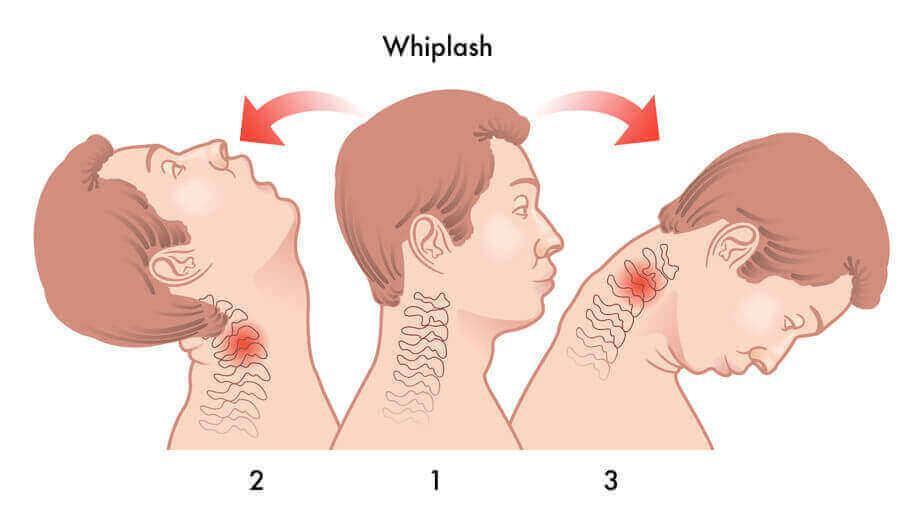What are the symptoms of whiplash?
Whiplash is a neck injury caused by sudden or forceful movement of the head, often due to a rear-end car collision. Symptoms of whiplash can vary in severity but generally include:
- Neck Pain and Stiffness: Often the most common symptom, with pain that can be localized or radiate into the shoulders.
- Headaches: Typically originating at the base of the skull and extending toward the forehead.
- Dizziness: A sensation of lightheadedness or unsteadiness.
- Fatigue: Feeling unusually tired or worn out.
- Shoulder Pain: Discomfort or pain in the shoulder region.
- Back Pain: Particularly in the upper back.
- Jaw Pain: Discomfort or pain in the jaw area, sometimes referred to as temporomandibular joint (TMJ) pain.
- Arm Pain: Pain or tingling that can extend into the arms and hands.
- Reduced Range of Motion: Difficulty moving the neck in certain directions.
- Numbness or Tingling: Sensations of numbness or tingling in the arms or hands.
- Difficulty Concentrating: Trouble focusing or memory problems, often referred to as “whiplash-associated disorder” (WAD) symptoms.
- Sleep Disturbances: Difficulty sleeping due to pain or discomfort.
If you experience these symptoms after an accident or injury, it’s important to seek medical attention for a proper diagnosis and treatment plan.
What are the causes of whiplash?
Whiplash is primarily caused by sudden and forceful movements of the head and neck. The most common causes include:
- Rear-End Car Accidents: The most frequent cause of whiplash, where a vehicle is struck from behind, causing the head to snap forward and backward.
- Sports Injuries: Contact sports or activities with sudden jerks or impacts, such as football, rugby, or skiing, can result in whiplash.
- Falls: Falling from a height or onto a hard surface can cause whiplash if the head and neck are subjected to a jarring motion.
- Physical Assaults: Situations involving physical violence, such as being struck or shaken violently, can lead to whiplash.
- Bungee Jumping or Roller Coasters: Activities involving rapid acceleration or deceleration can cause the head to move suddenly, leading to whiplash.
- Workplace Accidents: Injuries sustained in the workplace that involve sudden head or neck movements can also result in whiplash.
In all cases, the injury involves an abrupt movement that strains or damages the soft tissues of the neck, such as muscles, tendons, and ligaments.
What is the treatment for whiplash?
Treatment for whiplash typically involves a combination of methods aimed at relieving pain, reducing inflammation, and restoring function. Here’s a comprehensive approach:
- Rest: Initially, resting and avoiding activities that exacerbate symptoms can be helpful. However, prolonged inactivity should be avoided to prevent stiffness.
- Ice and Heat Therapy: Applying ice to the affected area during the first 48 hours can reduce swelling and numb the pain. Afterward, switching to heat therapy can help relax tight muscles and improve blood flow.
- Pain Relief Medications: Over-the-counter pain relievers like ibuprofen (Advil) or acetaminophen (Tylenol) can help manage pain and inflammation. In some cases, a doctor may prescribe stronger medications.
- Physical Therapy: Engaging in physical therapy can help restore neck strength and flexibility through exercises and stretching. A physical therapist can design a customized program to improve range of motion and reduce pain.
- Cervical Collar: In some cases, a soft cervical collar may be used for short periods to support the neck and reduce movement. It should not be used long-term as it can lead to muscle weakening.
- Massage Therapy: Gentle massage can help relieve muscle tension and improve circulation in the affected area.
- Heat Therapy: Applying heat, such as through warm compresses or a heating pad, can help relax the muscles and reduce pain after the initial inflammation has subsided.
- Chiropractic Care: Some people find relief through chiropractic adjustments, which aim to correct misalignments in the spine and improve neck mobility.
- Cognitive Behavioral Therapy (CBT): For chronic pain or associated psychological symptoms, CBT can help manage pain perception and improve coping strategies.
- Lifestyle Modifications: Maintaining good posture and avoiding activities that strain the neck can help in the recovery process. Ergonomic adjustments to your workspace can also be beneficial.
If symptoms persist or worsen, it’s important to consult a healthcare professional for further evaluation and treatment options. In rare cases, severe or chronic whiplash may require more specialized interventions or diagnostic imaging to rule out other conditions.

Leave a Reply
You must be logged in to post a comment.